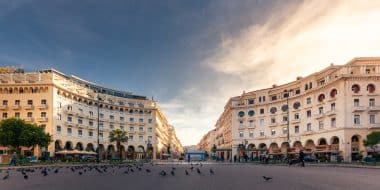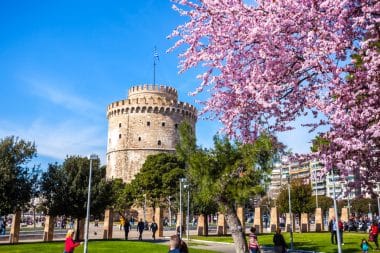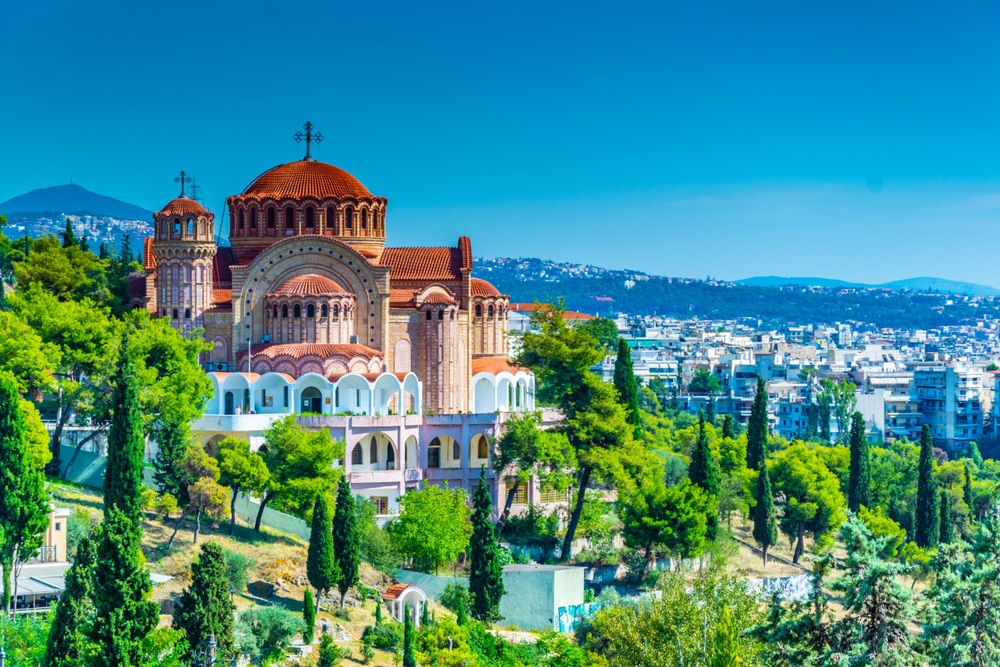Thessaloniki is a stunner just by looking at it: the city stretches along the sea to the Acropolis Hill with many small houses and is the second largest city in Greece. The metropolis is not regarded as such by the locals, but is seen as a traditional village with a lot of national pride.
If you stroll through the alleys and drift through the old town, you will notice that modernity meets the origins of the Byzantine era head-on here. Thessaloniki is hard to beat in terms of diversity. While the promenade along the harbor is very noble, relics of the Ottoman era can still be seen in the depths of the city. This special flair makes the city so worth seeing and brings a unique atmosphere.
How to get there

Thessaloniki can be reached in various ways by plane, car or long-distance buses – depending on your personal budget and the time available.
The larger German cities offer direct flights with which visitors can reach the city in about two and a half to a maximum of three hours flight time. From Thessaloniki Airport, buses or taxis take travelers to the city center – this option is time-saving and convenient.
There are also long-distance buses to Thessaloniki from large cities, which are usually relatively inexpensive, but also take a long time. However, if you are not pressed for time, you can travel quite comfortably and enjoyably with the bus companies. Most of the buses make a major stopover in Vienna and Bulgaria and are on the road for a total of around 30 hours.
Getting around the city
Exploring the city is quite easy, as the city network is compact and easily doable on foot. One tip is to start at the top and work your way down the beautiful alleys to the sea – this is especially advisable on hot days.
The bus network specialises in tourists with bus line 50 and runs along a “Cultural Route” to the most important sights at 16 stops. The ticket for this is very cheap and valid for 24 hours – the buses are correspondingly full.
Eight stops are also served by red hop-on hop-off buses, the use of which also includes audio guides for more detailed explanations of the sights.
If you are not good on foot and don’t feel like full buses in the high season, you can also resort to taxis in the classic way – but also a little deeper into your wallet.
Attractions in Thessaloniki
The White Tower

The White Tower was built in 1535 and is still considered a landmark of Thessaloniki today. Since it used to serve as a prison and torture chamber, it was given the name “The Red Tower” because its existence was marked by many bloody atrocities. It was not until 1890 that it was renamed “The White Tower” – the reason for this was one of the prisoners. He agreed to paint the tower white if he was released for it.
Meanwhile, the White Tower houses a museum about Byzantine culture. Due to its location by the sea, a visit to the tower can be perfectly combined with a walk along the five-kilometre-long waterfront.
Numerous museums
Thessaloniki has a rich cultural history, which can be admired in many museums.
The Archaeological Museum displays the remains that were found during the extensive excavations around the city and are well preserved. Also very interesting is the Museum of War History, which has exhibited old uniforms as well as weapons and orders of merit as well as other military remnants. Since Thessaloniki still has a fairly large Jewish community, the history of the Jewish population is documented in the Jewish Museum. Also worth seeing are the museums of photography and film as well as the Olympic Museum, which deals with the history of the Olympic Games from antiquity to modern times.
The old town of Ana Poli
The historic old town centre of Thessaloniki is located in the upper part of the city and invites you to take a stroll through the city with its narrow streets, small taverns and great atmosphere. Along the way, there are several Greek churches that are open to visitors, as well as the relaxing place Pasha ́s Gardens – a well-kept green area with fountains and comfortable seating.
Weekly markets
For fresh local products, the Kapani and Modiano markets are not to be missed. They are located next to each other and have an incredible variety of fresh fruit and vegetables, spices, antipasti, freshly caught fish, good sausage and farmhouse cheese. In the immediate vicinity, cosy taverns invite you to eat, enjoy an espresso or a cool drink, so that a visit to the market is ideal for rounding off your visit to the market.
Attractions in the area
Pella and Vergina
Pella and Vergina used to be the capitals of Macedonia and are now popular archaeological sites with relics worth seeing. Only an hour’s drive from Thessaloniki, they are a good day trip destination. Old royal tombs, jewellery, mosaics and the royal walls are well preserved and worth a visit.
Sithonia peninsula with Mount Athos
Long beaches, crystal-clear water and small coastal towns that invite you to linger: this is the Sithonia peninsula. Furthermore, it attracts with pure nature and Mediterranean vegetation and is perfect for hiking in the low season.
Insider tips for Thessaloniki
At the beginning of the city exploration, it is worthwhile to enjoy the sunrise from the Heptapyrgion. This is a fortress with a small café nearby – perfect for grabbing a first coffee for the view over Thessaloniki.
If you can enjoy silence, you should not miss the Vlatades Monastery. It is a UNESCO World Heritage Site and has a very beautiful courtyard that invites you to take a break in the shade.


